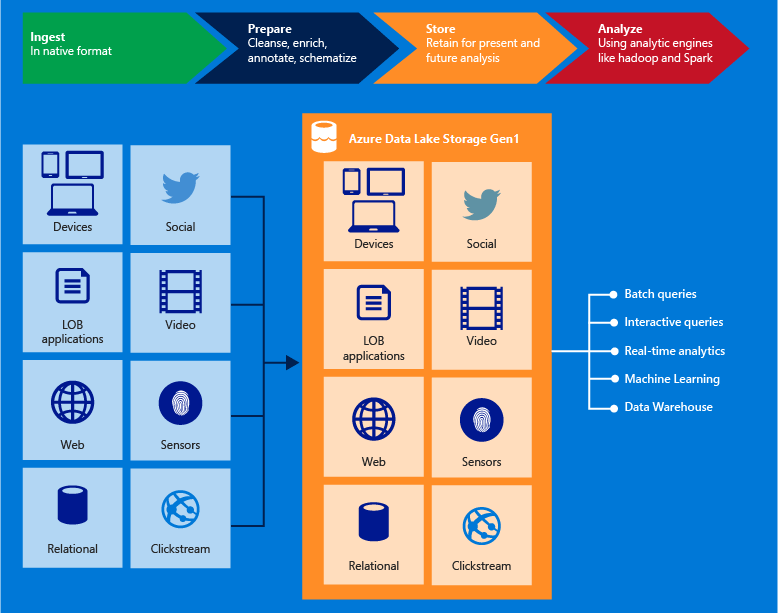



Data Lake is a big data solution based on several cloud services in the Microsoft Azure ecosystem. Azure Data Lake is part of the Microsoft Azure public cloud platform, which includes more than 200 products and cloud services.
It allows organizations to ingest multiple data sets, including structured, unstructured, and semi-structured data into an infinitely scalable data lake enabling storage, processing, and analytics.
Azure Data Lake is built on Azure Blob storage (Seriously Blob?), which is an object storage solution for the cloud. This solution integrates with other Azure services such as Azure Data Factory which is a tool for creating and running extract, transform and load (ETL) and extract, load and transform (ELT) processes and Hadoop YARN.
We understand this can be overwhelming, therefore and to be as simple as possible, Azure Data Lake works seamlessly while integrating with other Azure cloud services to allow you to deal with big data and large data sets more efficiently.
Like we mentioned previously, the Data Lake solution integrates with other Azure services, therefore, it’s safe to say we can count 4 services to be the building block of Data Lake on Azure.
Yes, Data lake is based in Azure Blob Storage, which is an elastic object storage solution with a weird name, that provides low-cost tiered storage, high availability, and robust disaster recovery capabilities.
The solution integrates Blob Storage with Azure Data Factory, and also uses Apache Hadoop YARN as a cluster management platform as well.
Previously known as Azure Data Lake store, ADLS is a massively scalable and secure data lake designed for high-performance analytics workloads and to eliminate data silos by providing a single storage platform that organizations can use to integrate their data.
With the help of Azure Data Lake Storage, users are able to optimize costs with tiered storage and policy management in addition to getting role-based access controls and single sign-on capabilities through Azure AD.
Not to mention that users also can manage and access data within ADLS using Hadoop Distributed File System (HDFS).
So, in a nutshell, any tool that you use and is based on HDFS will work seamlessly with Azure Data Lake Storage.

ADLS is considered an on-demand analytics platform for big data that allows users to run and develop massively parallel data transformation and processing programs in many different languages and environments like U-SQL, R, Python, and .NET over petabytes of data.
This is a cost-effective analytics solution because it simply offers you the ability to pay per job to process data on-demand in an Analytics as a Service environment.
Last but not least, Azure HDInsight is a cluster management solution that makes it easy, fast, and cost-effective to process a massive amount of data.
This service allows users to run popular open-source frameworks such as Spark, Kafka, and Apache Hadoop, in addition to leveraging these projects with fully managed infrastructures and cluster management, without the need for installation or customization.
It’s designed to help data scientists, data analysts, and developers take advantage of big data. The best part is that it allows you to store and manage data of any type and size plus run all types of processes on it across multiple platforms, environments, and programming languages. It can also work with the enterprise existing solutions, such as identity management and security solutions. Not to mention that it integrates with other data warehouses and cloud environments.
If you’re looking to get more value out of the data sets you have, then don’t hesitate! Ctelecoms’ team of specialists will help you transform your data into insights and decisions to benefit your business.
Contact our team now at: https://www.ctelecoms.com.sa/en/Form15/Contact-Us
Read More: Why To Choose Microsoft Azure?